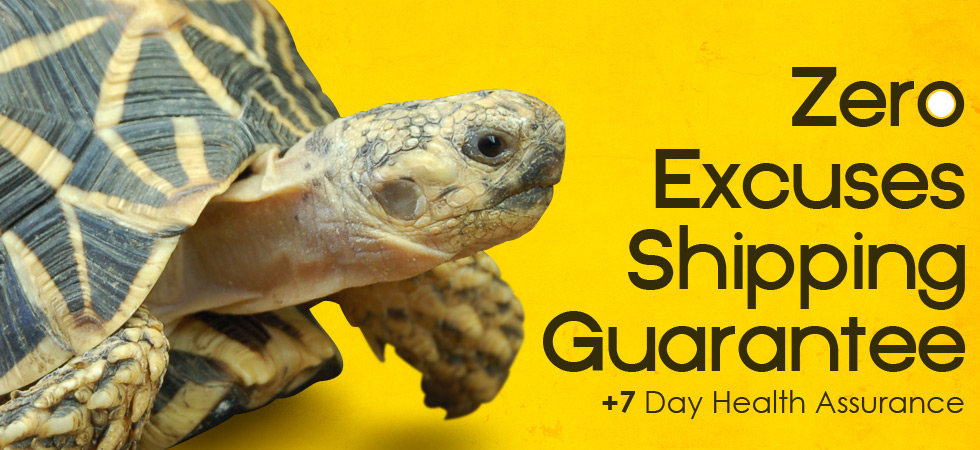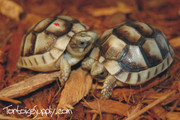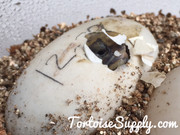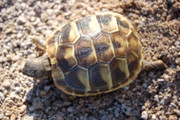Categories
- Tortoises For Sale
- Choose Your Exact Tortoise
- Lower Cost Tortoises For Sale
- Baby Tortoises For Sale (All Species)
- Pet Tortoises For Sale - 4" Size or Larger
- Egyptian Tortoises For Sale
- Greek Tortoises For Sale
- Hermanns Tortoises For Sale
- Leopard Tortoises For Sale
- Marginated Tortoises For Sale
- Pancake Tortoises For Sale
- Radiated Tortoises For Sale
- Redfoot Tortoises For Sale
- Russian Tortoises For Sale
- Star Tortoises For Sale
- Sulcata Tortoises For Sale
- Wholesale Tortoises
- Food Items
- Lighting
- Substrates
- Tortoise Kits & Cages
- Heat Mats & Heat Sources
- Cage Furniture & Bowls
- Supplements & Vitamins
- Seed Mixes
- Medical & Tools
- Books and Literature
- Waterland Tubs
- Toys & Gifts
- Shirts & Shipping Add-Ons
- Other Products
Russian Tortoise Care Sheet
Care sheet for the Russian tortoise (Testudo [Agrionemys] horsfieldii).
By Tyler Stewart
Written for use by Reptiles Magazine
Russian tortoises (Agrionemys horsfieldii) are a small species of tortoise native to many different countries including Uzbekistan, Afghanistan, Iran, Russia, China, Kazakhstan, Pakistan and others. European keepers often refer to them as “Horsfields tortoises,” although within the US, they are commonly called “Russian tortoises.” These tortoises live in areas with a generally dry climate with seasonal variations in temperature from hot to quite cold, well below freezing.
Russian tortoises are very round in shape when viewed from above, certainly compared to most tortoise species, and generally have a flattened top to their shell (not very high-domed). Their color is somewhat variable, but usually is a mixture of tans and browns, occasionally with some greenish color to it. The plastron (belly) is mostly black. Their skin color, including all of the head, is usually tan, dark gray or brown. Adult size on Russians tortoises is usually 5 to 6 inches for males, with females reaching 6 to 9 inches long. Within our breeding colonies, most males are right around 5 ½” length with most females ranging from 6” to 7”. Our largest Russian (female) is around 8” length. It’s not unheard of for them to reach 10”, but it is not very common.
In the wild, it is thought that a Russian tortoise’s activity levels are only at their peak around 3 months of the year. They will sometimes spend more than 6 months hibernating through the cold temperatures, and during the peak of the hot season, they will dig in and aestivate often without moving for weeks at a time in order to avoid the extreme heat at the surface. Because of this, most of their activity is early in the spring where the reproductive efforts take place, followed by an active period in the fall where they spend their efforts trying to “fatten up” before the long winter ahead. During the winter hibernation, these tortoises seem to know how far down they need to be in order to stay below the “danger zone” with the temperatures. Even within our outdoor enclosures we notice them adjusting and moving around in the winter, probably in an effort to stay more comfortable in the cold temperatures.
Like almost all species of tortoises, they face many threats in the wild including habitat destruction, competition with grazing animals for food, and the pet trade all putting strain on the wild populations. Fortunately for Russian tortoises, they have a massive range for a single tortoise species, so they aren’t at risk as much as many other species in the wild.
Russian tortoises are imported into the Unites States and many other countries on a regular basis, and have been for many years. The vast majority of these end up in the big box pet retailers. Imported Russian tortoises are generally somewhere between 4” and 5” length, and usually are a mix of sexes. These females are too small to be productive quite yet, and are usually 2 to 4 well-fed years from being large enough to produce babies. Imported Russian tortoises also seem to need an “adaptation period” of a few years once moved to a new area or climate to get an understanding of the seasons, the availability of food and feel comfortable enough to spend valuable resources on reproductive efforts. If they don’t have these things, they generally won’t settle in and eventually reproduce. We have noticed the same “wait period” when acquiring tortoises from Florida that were producing in Florida, once moved to Las Vegas, they stopped producing for a few years until they adjusted to the environment here.
Buying an imported, wild caught tortoise can be extremely hit or miss. In our experience, if you can get them immediately after import, they are in good shape and usually do very well. If they spend any significant amount of time at an importer’s facility, particularly one in a humid climate, they tend to deteriorate rather quickly and can be more complicated to establish. The same holds true with a big box store, unless they are getting great care, the longer they are there, generally the worse off they are. For these reasons, when we are buying imported Russians, we buy them at the time of import, and immediately house them outdoors in our hot/dry climate that helps to get them back to normal after the transition process in a very stress free way. We designed pens that are easy to clean and sterilize so that we can work on the deworming process after getting them and be able to have a “clean slate” for the next group down the road, rather than keeping years worth of repeated imports in the same enclosures that are impossible to clean well. Our hot climate and 4” of rainfall per year are also a huge assistance in cleaning out our pens and animals naturally.
Of course, there are always captive bred babies! Russian tortoises are slow reproducers in the tortoise world, but it’s not impossible. Their small clutch size of usually 2 to 4 eggs a few times a year can make it difficult to produce enough to meet the demand. Our Russian tortoises here in Las Vegas, Nevada usually come out of hibernation in late February and waste no time in getting very active, very hungry and very frisky almost immediately. Breeding takes place constantly within a few days of emerging from hibernation. We will start getting eggs in March, and babies are hatching generally 60-65 days later. Nests are often missed in the outdoor enclosures, but the babies have a very good hatch rate out of the ground here, so we will still see a second “wave” of babies in late August and early September. Occasionally our Russians will lay a single clutch in the fall that will hatch on a warm winter day or sometimes in the spring after over-wintering in the ground. Eggs don’t develop in cold temperatures, but they don’t necessarily die, either. Once it warms back up, most of them pick up development where they left off. Because of all these variables, we potentially get babies in almost any season of the year, but the bulk of them are between June and September.
Russian tortoises are very often bought as a “first pet tortoise,” often to inexperienced buyers. There’s nothing wrong with that, as they are very forgiving tortoises. Their low cost, good availability and hardiness make them suitable tortoises for someone to get their feet wet.
Very often, Russian tortoises are purchased with the intent of keeping them indoors. This can be done properly, but it does take a few key things. The enclosure itself cane be made of almost anything. For a very basic setup, many people use the large plastic concrete mixing tubs that are available at hardware stores, or the under-bed sweater boxes available at many sources. You want the footprint to be as large as possible. Ideally, a single adult 4”+ size should have an enclosure at least 4 to 6 square feet (2x2 feet or 2x3 feet). Any smaller than this, and the tortoises will spend the majority of their day trying to escape. The walls of the enclosure don’t need to be high, usually 8-10” wall height will contain them. It doesn’t hurt to go taller, but it makes accessing the cage more problematic. If you are sunning them outside, you may want to keep them a little taller if an escape would mean a loss of the tortoise (getting out of your yard, into a meadow, etc).
For young adult Russians, our favorite substrate is cypress mulch. It’s commonly available, retains moisture or dryness well, isn’t very dusty and provides a stable platform while allowing burrowing. With baby Russian tortoises, we usually use coco coir and sometimes peat moss, with a preference for coco coir (less dusty). With babies, we always maintain some moisture in the substrate which helps keep them from drying out. Babies in the wild spend a huge amount of time underground in cooler, humid burrows and microclimates. In our opinion, sand should not be used as a substrate for indoor tortoises. It remains loose indoors, sticks to food items and gets eaten, and can be a major irritant to the eyes. Additionally, loose sand is almost too soft. The argument is often made that they live on sand or dirt in the wild, so people often use it indoors, but in the wild, the dirt is hard packed and weathered, not loose and sandy. They also are eating their food from low growing bushes and shrubs, not eating it directly off of the substrate as they often do in captivity. Sand and gravel impaction kills many captive tortoises every year. Almost all of them are living on loose sand or dirt indoors. We have never had impaction problems with cypress or coco coir, and while there probably is some risk potential with any substrate, they should be fed from a plate or platter rather than directly from the substrate.
Indoor Russian tortoises need intense lights to maintain an active lifestyle. Dark cages lead to depressed and inactive tortoises. Our favorite light bulbs for all tortoises are ZooMed brand Powersun mercury vapor bulbs (shout out for ZooMed on this great product). Mercury vapor bulbs are an all-in-one bulb that handles the heat, light and UVB needs within a single bulb. Lights can also be arranged with tube UVB lights and a separate heat light, but we like the simplicity of a single bulb that “does it all.” With the fluorescent light bulbs, my preference is the ZooMed 10.0 UVB bulbs, and we typically run twin bulbs 48” length over two or three enclosures (enclosures set side by side, the 48” bulb can cover a few enclosures). Along with proper lighting comes proper temperatures. Russian tortoises don’t need a heat source at night as long as they are heating up properly during the day. In an indoor setup, we generally recommend that the hottest part of the enclosure be somewhere around 95-100 degrees, directly under the basking bulb. Keep in mind, the tortoise’s shell will be 2-3 inches higher than this, closer to the bulb, so in the early setup days we would place a rock the size of a tortoise under the bulb and let it “max out” in temperature, and then measure the surface temperature of the rock. It’s often much hotter than the surface just 2 inches below it, so you want the tortoise to max out around 100 degrees, not the substrate. Babies are probably best kept between 90-95 degrees, as they dry out faster and don’t really need it as hot as the adults prefer. The hottest part of the enclosure should be limited to about 10-20% of the square footage in the enclosure, and the rest of the enclosure should taper down to room temp. All heat and lights should be off at night. This day/night light and temperature cycle is important for tortoises and helps them establish natural patterns.
Diet is another very important part of tortoise keeping. Many people think lettuce is all they need, and misshapen tortoises can be the result a few years down the road. While greens like romaine lettuce aren’t necessarily a bad thing, they aren’t a great staple diet, especially for growing young tortoises. Looking back to the natural tortoise in the wild, they eat a large variety of foods. We sometimes joke that their natural diet has the nutritional equivalent of cardboard. In reality, it’s only slightly better. For these reasons (and the fact that they are buried in the ground 8-9 months of the year), wild tortoises grow very slowly. They make up for the lack of nutrition in their diet items by eating this and that, all day long. Their goal in life is to wake up, search for new food items, maybe check out a female if it’s April or May, search for food again, and then go to bed. In captivity, they are usually offered foods that are about 100 times more “rich” than what is natural for them and it’s usually offered once a day in a heaping pile. Again, this isn’t all a bad thing, and isn’t something that is easy to overcome in captivity, but it should be kept in mind that the ideal diet is dry, rough, bland, and high in fiber and calcium. We often suggest spring mix greens as a good “general” diet for Russian tortoises because it’s easy and available all over the place. The variety is good in spring mix, but a more ideal diet would be leafy weeds like dandelion, plantain, mallow and leaves like mulberry, grape, hibiscus and pumpkin/squash leaves. Adding some or most of these items to the diet of your tortoise will do great things for them, and the roughage in their digestive system helps to keep them healthy. We also use a lot of fresh veggies such as bell pepper, squash, almost any leafy green in some amount, prickly pear cactus pads, carrots, clovers, and many other things. After Halloween, we stash some leftover, un-carved pumpkins and break them apart in the spring for tortoise food. At a cool garage temperature, they hadn’t changed a bit and didn’t expire or mold. With smaller tortoises, we usually put these harder items in a food processor and dice them into something we can offer them in bite-sized pieces. Larger tortoises can be offered veggies as-is, and I think the fight for them to eat away at the squash is good for their strength and for their beaks. We joke that soft foods on a silver platter make sissy tortoises. With a large enough variety in the diet, the need for supplementation can be questionable, but just to cover all the bases we offer a calcium/D3 supplement twice a week for babies and a multivitamin once a week, about half as much for young adults. Tortoises housed outdoors get calcium only a few times a year and it’s calcium without D3.
Water is very important for all tortoises, but it’s extremely important for baby tortoises. We firmly believe that the biggest killer of baby tortoises is dehydration, whether they aren’t getting enough physical water, or they aren’t kept in a humid microclimate. Some old literature suggests that since they live in a dry area that they have no water requirements, or a few inches a year of water requirements. Some also suggests that since it can be 110 degrees in their natural range, that 110 degrees is a temperature they need to be. In reality, they are long gone by the time it’s 90 degrees outside during the day. I can assure you that a Russian tortoise held at 110 degrees with no water wouldn’t last long at all. A baby in those extremes would be dead within a few hours. Heat dries them out quickly, particularly as babies, so while they can handle heat for some time, they need their water intake both in physically drinking and in humidity to be keeping up with it. There are no baby tortoise species we raise that we don’t keep moisture in the substrates, and all species have access to a hidebox that maintains extremely high humidity (over 80%). This microclimate need is the least understood part of tortoise-keeping, and leads to many problems and deaths of animals for unknown reasons by their owners. Babies in all species should be soaked in shallow, warm water for a half hour at least 3-4 times a week. Soaking them daily is even better, in my opinion. With adults, it’s much less critical, as their shells have hardened, skin thickened and they have adapted to the ability to hold water within their bodies much better than babies.
Cage furniture can be kept pretty minimal. We like to provide all indoor tortoises with at least one hide area if not two (one in the cooler part and one in the warm area of the enclosure). Food dishes can be fancy or very simple. We often use paper plates just because they are easy to swap out rather than having to scrub and clean out ceramic dishes. Water bowls can be used, but we usually just soak the tortoises regularly, we think that is less work than maintaining a clean dish in the cage, and you are able to “force hydration” with the manual soakings. A large flat rock or two is useful in the indoor enclosure because it will help maintain healthy toenail length as they walk around on it, and used as a food platter, it will maintain their healthy beak also.
Outdoor housing is our preferred method for keeping Russian tortoises, as we are fortunate to live in a climate where they can be housed outdoors all year and kept with very little maintenance. We range from about 20 degrees up to 115 in an average summer, and with a proper setup (options available to the tortoises), they do very well here. Our pens are built with stained 2x6 and 2x12 lumber generally 12-16” above ground and buried 6” below ground (Russians can be diggers). In a dry climate, wood works very well for this purpose. Russian tortoises will occasionally dig around in a corner, but you can place a large flat rock there and bury it a bit and they quickly give up, at least in that corner. In some areas, we cap all the corners with an overhang since the corners are where essentially all escape attempts are made. Taller walls can be used for better containment, but too tall and they are obstructive for viewing and difficult for airflow/temperature control (in a deep box, the temperature can get stagnant much more than in a low sided enclosure with more air exchange). Because of the air exchange issue with outdoor enclosures, we prefer that they are about 40 square feet (5x8’) at a minimum. In any smaller enclosures, I have a hard time getting the temperature gradients that I want, the sunny areas versus the shade, the dry versus the damp, etc. Tortoises are solar-powered, and outdoor tortoises thrive when given options. They are smart, and they know what they need and want, but they need those options to be available to them. We shade our enclosures with mesquite trees which drop their leaves in the winter letting more sun through, and grow in a shade canopy in the warmer months. They are also easy to shape and prune, so you can keep a part of the enclosure full sun and most other areas shaded or broken shade during the summer.
We build wood hideboxes in every enclosure with a small door that gives the tortoises a place to retreat to from the sun, and it is usually where they will hibernate through the winter. The boxes don’t need to be large, just enough for each tortoise to fit and then maybe 50% more space so they can arrange themselves within it. We put a 6” layer of sand or cypress in the hideboxes for burrowing and hibernating. In a perfect world, the tops of these boxes are in the shade during the summer months (under a tree) which helps keep the interior of the boxes cooler, and we try to arrange or place the hideboxes to be in full sun most of the day during the winter which helps it not get too cold at night (the sand within the box warms up a bit during the day and cools off at night, rather than just cooling at night). I like to keep the entrances as small or tight as possible so that there aren’t unnecessary drafts of air blowing in and out the door.
There is a long list of plants that can be used in an outdoor enclosure, but first and foremost, I would suggest going to a nursery and finding the plants that you like, find ones that will do well in your climate and in your situation, and then go home and research them and see which are toxic to animals, or even better, find them referred to as tortoise-appropriate. For several years I bought the plants I thought were tortoise appropriate, many of them I ordered online because they weren’t available here, and after fighting to keep them alive all along, I got smart and started buying with the climate first, rather than types like hibiscus that have a hard time in Vegas (they struggle in the summers and struggle in the winters). We use many types of sage here, pampas grass, yellow iris grass and deer grass (mostly for shade, they don’t eat the clump grasses too much), cassia, morning glory, prickly pear and globe mallow which is a native plant I can go dig up on our property and transfer to the tortoise pens. All of these have extremely low water requirements once established. We also have mulberry trees growing nearby (over our sulcata pens) which can be a great food source. In addition to all the plants, I like to have some boulders in the pens and rolling hills, different elevations and other naturalistic objects just to break up the rectangular enclosures.
Russian tortoises are great tortoises for new and experienced keepers. In our large collection, I’m not sure there’s a tortoise that is more eager to see you when you walk out there than the Russians. They are very food-motivated and fun, eager, active tortoises. Their small size and wide temperature tolerances make them easy to keep in a large variety of climates and situations.
Featured Products
-
$160.00

-
$350.00

-
$225.00

-
$250.00

 Loading... Please wait...
Loading... Please wait...








